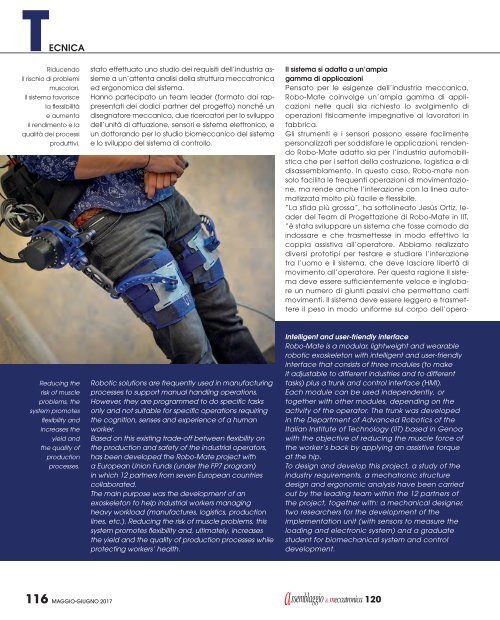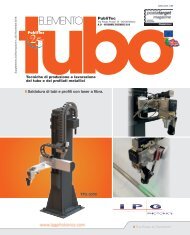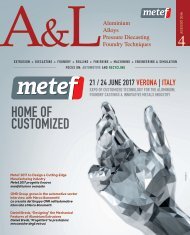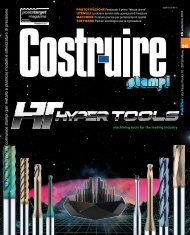AsseMec120_MAGGIU_2017
Create successful ePaper yourself
Turn your PDF publications into a flip-book with our unique Google optimized e-Paper software.
TECNICA<br />
Riducendo<br />
il rischio di problemi<br />
muscolari,<br />
il sistema favorisce<br />
la flessibilità<br />
e aumenta<br />
il rendimento e la<br />
qualità dei processi<br />
produttivi.<br />
stato effettuato uno studio dei requisiti dell’industria assieme<br />
a un’attenta analisi della struttura meccatronica<br />
ed ergonomica del sistema.<br />
Hanno partecipato un team leader (formato dai rappresentati<br />
dei dodici partner del progetto) nonché un<br />
disegnatore meccanico, due ricercatori per lo sviluppo<br />
dell’unità di attuazione, sensori e sistema elettronico, e<br />
un dottorando per lo studio biomeccanico del sistema<br />
e lo sviluppo del sistema di controllo.<br />
Il sistema si adatta a un’ampia<br />
gamma di applicazioni<br />
Pensato per le esigenze dell’industria meccanica,<br />
Robo-Mate coinvolge un’ampia gamma di applicazioni<br />
nelle quali sia richiesto lo svolgimento di<br />
operazioni fisicamente impegnative ai lavoratori in<br />
fabbrica.<br />
Gli strumenti e i sensori possono essere facilmente<br />
personalizzati per soddisfare le applicazioni, rendendo<br />
Robo-Mate adatto sia per l’industria automobilistica<br />
che per i settori della costruzione, logistica e di<br />
disassemblamento. In questo caso, Robo-mate non<br />
solo facilita le frequenti operazioni di movimentazione,<br />
ma rende anche l’interazione con la linea automatizzata<br />
molto più facile e flessibile.<br />
“La sfida più grossa”, ha sottolineato Jesús Ortiz, leader<br />
del Team di Progettazione di Robo-Mate in IIT,<br />
“è stata sviluppare un sistema che fosse comodo da<br />
indossare e che trasmettesse in modo effettivo la<br />
coppia assistiva all’operatore. Abbiamo realizzato<br />
diversi prototipi per testare e studiare l’interazione<br />
tra l’uomo e il sistema, che deve lasciare libertà di<br />
movimento all’operatore. Per questa ragione il sistema<br />
deve essere sufficientemente veloce e inglobare<br />
un numero di giunti passivi che permettano certi<br />
movimenti. Il sistema deve essere leggero e trasmettere<br />
il peso in modo uniforme sul corpo dell’opera-<br />
Reducing the<br />
risk of muscle<br />
problems, the<br />
system promotes<br />
flexibility and<br />
increases the<br />
yield and<br />
the quality of<br />
production<br />
processes.<br />
Robotic solutions are frequently used in manufacturing<br />
processes to support manual handling operations.<br />
However, they are programmed to do specific tasks<br />
only and not suitable for specific operations requiring<br />
the cognition, senses and experience of a human<br />
worker.<br />
Based on this existing trade-off between flexibility on<br />
the production and safety of the industrial operators,<br />
has been developed the Robo-Mate project with<br />
a European Union Funds (under the FP7 program)<br />
in which 12 partners from seven European countries<br />
collaborated.<br />
The main purpose was the development of an<br />
exoskeleton to help industrial workers managing<br />
heavy workload (manufactures, logistics, production<br />
lines, etc.). Reducing the risk of muscle problems, this<br />
system promotes flexibility and, ultimately, increases<br />
the yield and the quality of production processes while<br />
protecting workers’ health.<br />
Intelligent and user-friendly interface<br />
Robo-Mate is a modular, lightweight and wearable<br />
robotic exoskeleton with intelligent and user-friendly<br />
interface that consists of three modules (to make<br />
it adjustable to different industries and to different<br />
tasks) plus a trunk and control interface (HMI).<br />
Each module can be used independently, or<br />
together with other modules, depending on the<br />
activity of the operator. The trunk was developed<br />
in the Department of Advanced Robotics of the<br />
Italian Institute of Technology (IIT) based in Genoa<br />
with the objective of reducing the muscle force of<br />
the worker’s back by applying an assistive torque<br />
at the hip.<br />
To design and develop this project, a study of the<br />
industry requirements, a mechatronic structure<br />
design and ergonomic analysis have been carried<br />
out by the leading team within the 12 partners of<br />
the project, together with: a mechanical designer,<br />
two researchers for the development of the<br />
implementation unit (with sensors to measure the<br />
loading and electronic system) and a graduate<br />
student for biomechanical system and control<br />
development.<br />
116 MAGGIO-GIUGNO <strong>2017</strong><br />
& meccatronica 120





